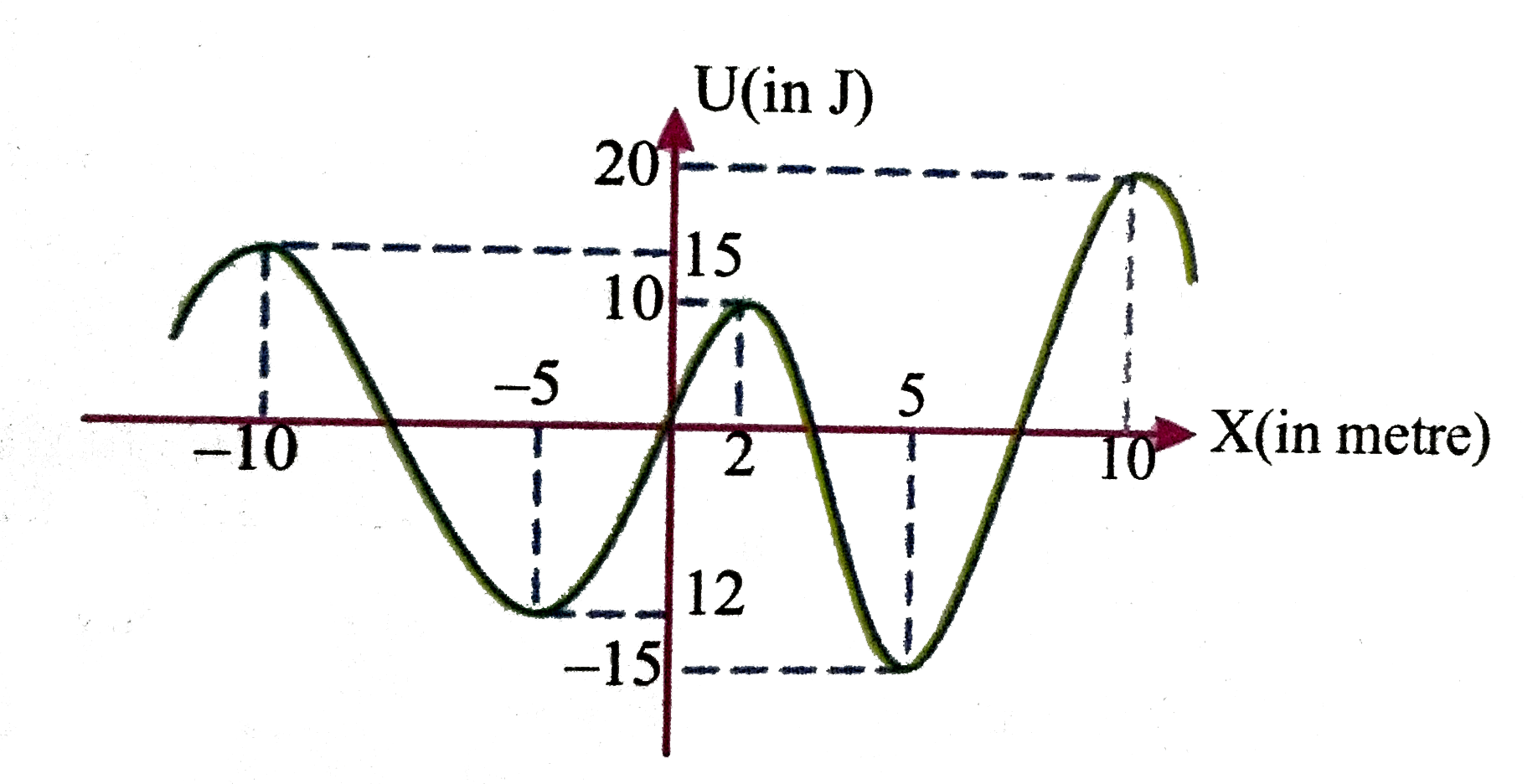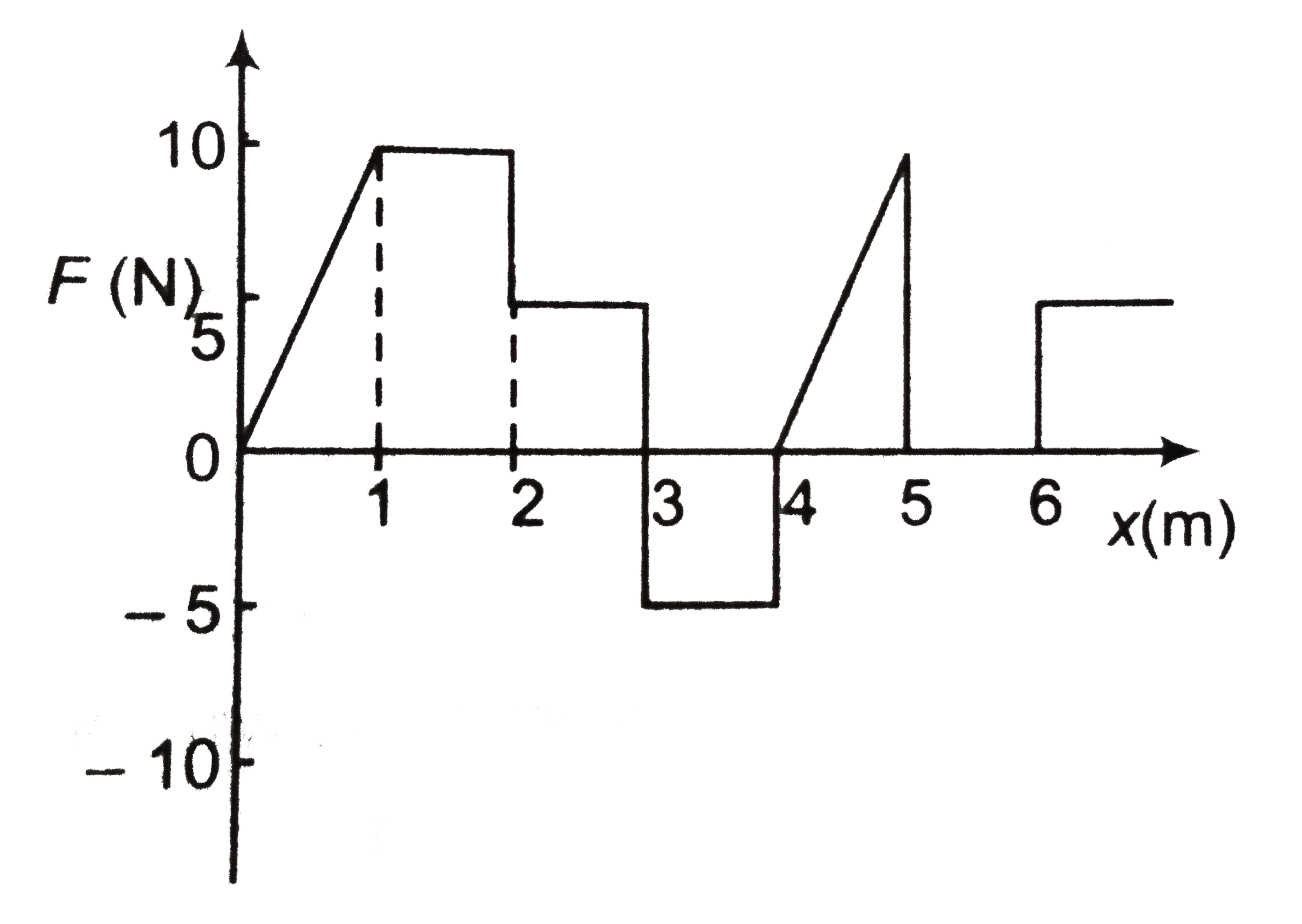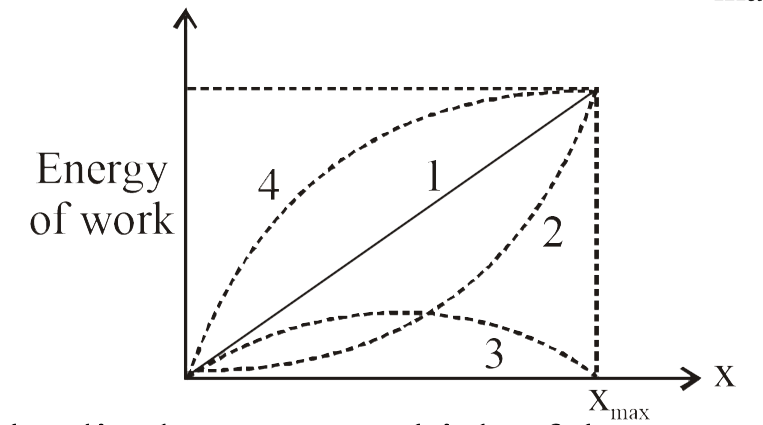Complete Solutions to Physics of chapter WORK, ENERGY AND POWER of Class 11 book with complete answers and questions
| Class 11 | PHYSICS |
| Chapter | WORK, ENERGY AND POWER |
| DISHA | Physics |
| Number Of Questions | 46 |
| Academic Year | 2023-24 |
A spring of spring constant `5 xx 10^(3) N//m` is stretched initially by 5 cm from the unstretched position. The work required to further stretch the spring by another 5 cm is .
04:34View SolutionA paritcal of mass `10 g` moves along a circle of radius `6.4 cm` with a constant tangennitial acceleration. What is the magnitude of this acceleration . What is the magnitude of this acceleration if the kinetic energy of the partical becomes equal to `8 xx 10^(-4) J` by the end of the second revolution after the beginning of the motion?
02:11View SolutionA body is moved along a straight line by a machine delivering constant power . The distance moved by the body is time `t` is proptional to
02:54View SolutionA ball is projected vertically down with an initial velocity from a height of `20 m` onto a horizontal floor. During the impact it loses `50%` of its energy and rebounds to the same height. The initial velocity of its projection is
05:46View SolutionA cord is used to lower vertically a block of mass `M`, a distance `d` at a constant downward acceleration of `(g)/(4)`, then the work done by the cord on the block is
03:12View SolutionA rubber ball is dropped from a height of `5m ` on a plane, where the acceleration due to gravity is not shown. On bouncing it rises to `1.8 m.` The ball loses its velocity on bouncing by a factor of
04:06View SolutionThe first ball of mass `m` moving with the velocity `upsilon` collides head on with the second ball of mass `m` at rest. If the coefficient of restitution is `e`, then the ratio of the velocities of the first and the second ball after the collision is
04:49View SolutionA partical of mass `m` is driven by a machine that deleveres a constant power `k` watts. If the partical starts from rest the force on the partical at time `t` is
03:59View SolutionUnder the action of a force, a `2 kg` body moves such that its position x as a function of time is given by `x =(t^(3))/(3)` where x is in metre and t in second. The work done by the force in the first two seconds is .
01:54View SolutionA sphere of mass `8m` collides elastically (in one dimension) with a block of mass `2m`. If the initial energy of sphere is E. What is the final energy of sphere?
07:35View SolutionTwo similar springs `P` and `Q` have spring constants `K_(P)` and `K_(Q)`(`K_(P)gtK_(Q))`. They are stretched first by the same amount `(` case `a)`,then by the same force `(` case `b)`. The work done by the spring `W_(P)` and `W_(Q)` are related as, in case `(a)` and case `(b)`, respectively.
03:26View SolutionIn the figure the variation of potential energy of a particle of mass `m = 2kg` is represented w.r.t. its x-coordinate. The particle moves under the effect of this conservative force along the x-axis.

If the particle is released at the origin then02:24View SolutionThe potential energy of a certain spring when stretched through a distance 'S' is `10` joule. The amount of work (in joule) that must be done on this spring to stretch it through an additional distance 'S' will be
04:01View SolutionA force applied by an engine of a train of mass `2.05xx10^6`kg changes its velocity from 5 m/s to 25 m/s in 5 minutes. The power of the engine is
02:29View SolutionThe relationship between the force F and position x of body is as shown in figure. The work done in displacing the body in displacing the body from (`x = 1 m` to `x = 5 m`) will be
 . 05:12View Solution
. 05:12View SolutionA body is allowed to fall freely under gravity from a height of `10m.` If it looses `25%` of its energy due to impact with the ground, then the maximum height it rises after one impact is
02:28View Solution Block C of mass M is moving with velocity `V_(0)` and collides elastically with block A of mass M and connected to another block B of mass 2M through a spring of spring constant K. What is K if `X_(0)` is the compression of spring when velocity of A and B is same 03:19View Solution
Block C of mass M is moving with velocity `V_(0)` and collides elastically with block A of mass M and connected to another block B of mass 2M through a spring of spring constant K. What is K if `X_(0)` is the compression of spring when velocity of A and B is same 03:19View SolutionTwo springs of force constants `300 N/m` (Spring A) and `400 N/m` (Spring B) are joined together in series. The combination is compressed by `8.75 cm.` The ratio of energy stored in A and B is `(E_(A))/(E_(B)) "Then" (E_(A))/(E_(B))` is equal to:
06:55View SolutionA body of mass `1 kg` begins to move under the action of a time dependent force `vec F = (2 t hat I + 3 t^(2) hat j) N`, where `hat i` and `hat j` are unit vectors along x-and y-axes. What power will be developed by the force at the time `t` ?
04:16View SolutionA bullet of mass `20 g` and moving with `600 m/s` collides with a block of mass `4 kg` hanging with the string. What is the velocity of bullet when it comes out of block, if block rises to height `0.2 m` after collision?
04:13View SolutionA body of mass m kg is ascending on a smooth inclined plane of inclination `theta(sintheta=(1)/(x))` with constant acceleration of a `m//s^(2).` The final velocity of the body is v `m//s^(2).` The work done by the body during this motion is (Initial velocity of the body = 0)
03:27View SolutionA glass marble dropped from a certain height above the horizontal surface reaches the surface in time t and then continues to bounce up and down. The time in which the marble finally comes to rest is
06:23View SolutionThe potential energy of a `1 kg` particle free to move along the x- axis is given by `V(x) = ((x^(4))/(4) - x^(2)/(2)) J`
The total mechainical energy of the particle is `2 J` . Then , the maximum speed (in m//s) is03:33View SolutionWater falls from a height of `60 m` at the rate `15 kg//s` to operate a turbine. The losses due to frictional forces are `10%` of energy . How much power is generated to by the turbine? (g=10 m//s^(2))`.
01:33View SolutionA car of mass `m` starta from rest and accelerates so that the instyantaneous power delivered to the car has a constant magnitude `P_(0)`. The instaneous velocity of this car is proportional to
00:57View SolutionWhen a `1.0kg` mass hangs attached to a spring of length `50 cm,` the spring stretches by `2 cm.` The mass is pulled down until the length of the spring becomes `60 cm.` What is the amount of elastic energy stored in the spring in this condition. if `g = 10 m//s^(2).`
03:13View SolutionA block of mass m rests on a rough horizontal surface (Coefficient of friction is` µ`). When a bullet of mass `m//2` strikes horizontally, and get embedded in it, the block moves a distance d before coming to rest. The initial velocity of the bullet is `ksqrt(2mugd),` then the value of k is
 04:11View Solution
04:11View SolutionA force act on a `30 gm` particle as a friction of the particle as a function as given by `x = 3 t - 4 t^(2) + t^(3)`, where `x` is in metros and `t` is in seconds. The work done during the first `4` second is
06:27View SolutionA body of mass `M_(1)` collides elastically with another mass `M_(2)` at rest. There is maximum transfer of energy when :
02:16View SolutionA ball of mass 'm' moving with a horizontal velocity 'v' strikes the bob of mass 'm' of a pendulum at rest. During this collision, the ball sticks with the bob of the pendulum. The height to which the combined mass raises is (g = acceleration due to gravity).
03:51View SolutionA 10 H.P. motor pumps out water from a well of depth 20 m and fills a water tank of volume 22380 litres at a height of 10 m from the ground. The running time of the motor to fill the empty water tank is (`g=1=ms^(-2)`)
03:06View SolutionA particle of mass m1 is moving with a velocity `v_(1)` and another particle of mass `m_(2)` is moving with a velocity v2. Both of them have the same momentum but their different kinetic energies are E1 and E2 respectively. If `m_(1) gt m_(2)` then
02:49View SolutionA bolck of mass `10 kg` is moving in x-direction with a constant speed of `10 m//s`. it is subjected to a retardeng force `F=-0.1 x J//m`. During its travel from `x =20m` to `x =30 m`. Its final kinetic energy will be .
03:38View SolutionIdentify the false statement from the following
02:12View SolutionA one-ton car moves with a constant velocity of `15 ms^(–1)` on a rough horizontal road. The total resistance to the motion of the car is `12%` of the weight of the car. The power required to keep the car moving with the same constant velocity of `15ms^(–1)` is [Take `g=10ms^(-2)`]
01:23View SolutionA ball is dropped from the top of a tower. The ratio of work done by force of gravity in `1^(st), 2^(nd)`, and `3^(rd)` second of the motion of ball is
04:11View SolutionTwo sphere `A and B` of masses `m_(1) and m_(2)` respectivelly colides. A is at rest initally and `B` is moving with velocity `v` along x-axis. After collision `B` has a velocity `(v)/(2)` in a direction perpendicular to the original direction. The mass `A` moves after collision in the direction.
08:19View SolutionA `2kg` block slides on a horizontal floor with the a speed of `4m//s` it strikes a uncompressed spring , and compresses it till the block is motionless . The kinetic friction force is compresses is `15 N` and spring constant is `10000 N//m` . The spring by
03:58View SolutionA uniform chain of length `2m` is kept on a table such that a length of `60 cm` hangas freely from the adge of the table . The table . The total mass of the chain ia `4 kg` What is the work done in pulling the entire the chain the on the table ?
02:46View SolutionA mass 'm' moves with a velocity 'v' and collides inelastieally with another identical mass . After collision the `1^(st)` mass moves with velocity `v/sqrt3` in a direction perpendicular to the initial direction of motion. Find the speed of the `2^(nd)` mass after collision.
`undersetunderset ((before),(collision))(m)(*rarr) underset(m)* uparrow v//sqrt3 underset((after),(collision):)`02:27View SolutionA mass 'm' moves with a velocity 'v' and collides inelastieally with another identical mass . After collision the `1^(st)` mass moves with velocity `v/sqrt3` in a direction perpendicular to the initial direction of motion. Find the speed of the `2^(nd)` mass after collision.
`undersetunderset ((before),(collision))(m)(*rarr) underset(m)* uparrow v//sqrt3 underset((after),(collision):)`02:27View SolutionA spherical ball of mass `20kg` is stationary at the top of a hill of height `100m` , it rolls down a smooth surface to the ground , then climbs up another bill of height of `30 m` and final rolls down to a horizontal base at a height of `20 m` about the ground . The velocity attained by the ball is
03:07View SolutionA block of mass M is kept on a platform which is accelerated upward with a constant acceleration 'a' during the time interval T. The work done by normal reaction between the block and platform is
 02:20View Solution
02:20View SolutionA srping lies along the x-axis attached to a wall at one end and a block at the other end. The block rests on a friction less surface at `x=0`. A force of constant magnitude F is applied to the block that begins to compress the spring, until the block comes to a maximum displacement `x_(max)`.

During the displacement, which of the curves shown in the graph best represents the kinetic energy of the block?02:49View SolutionThe `K.E.` acquired by a mass `m` in travelling a certain distance `d`, starting from rest, under the action of a constant force is directly propotional to
02:22View SolutionA vertical spring with force constant `k` is fixed on a table. A ball of mass `m` at a height `h` above the free upper end of the spring falls vertically on the spring , so that the spring is compressed by a distance `d`. The net work done in the process is
01:11View Solution
Physics questions and complete solutions for chapter WORK, ENERGY AND POWER of DISHA PHYSICS (HINGLISH) of Class 11
